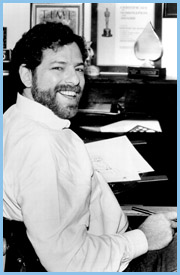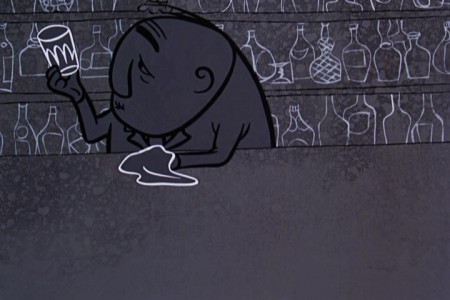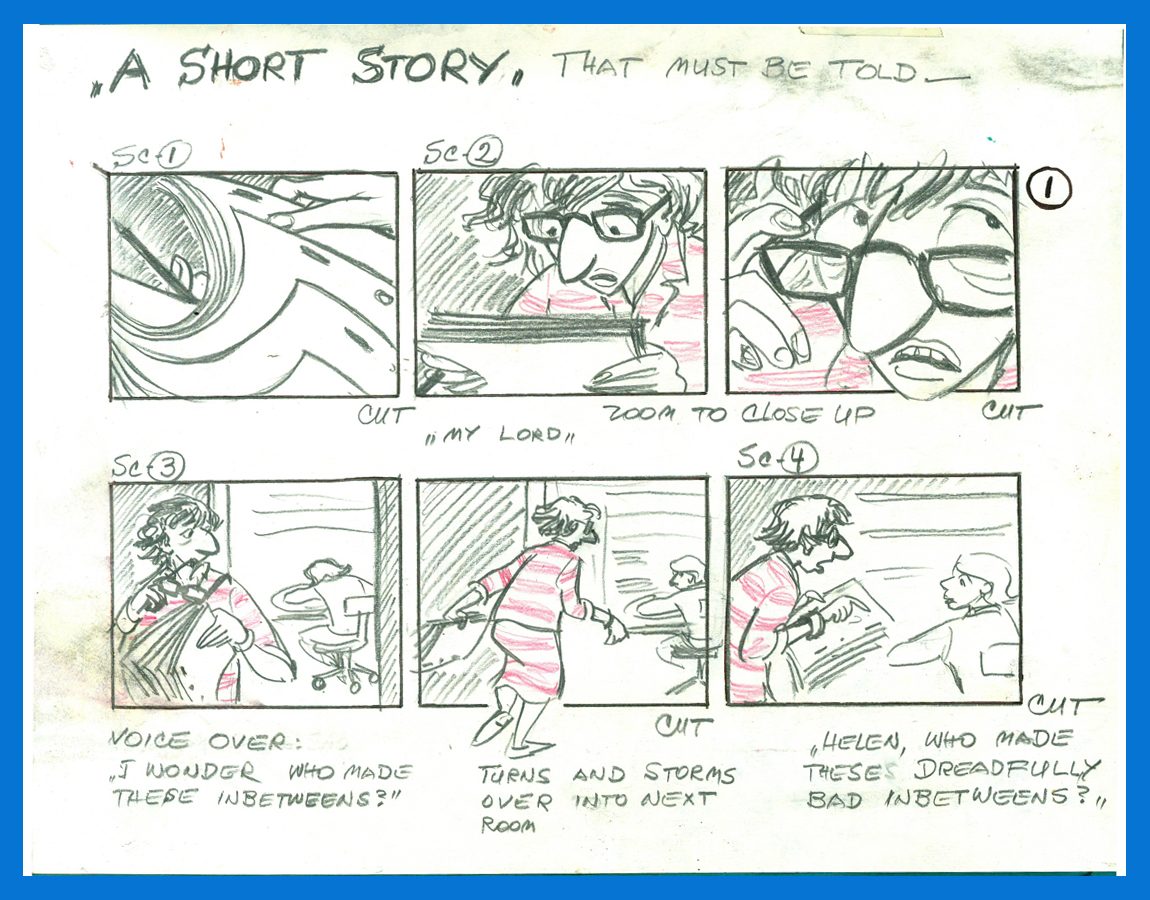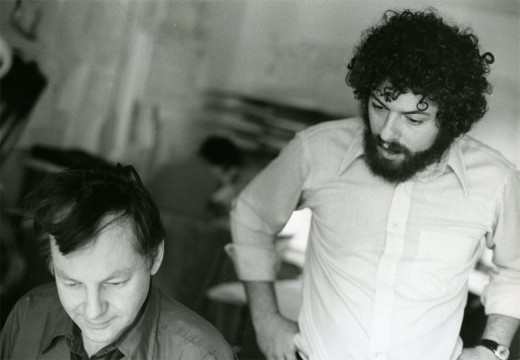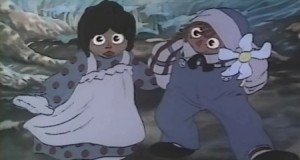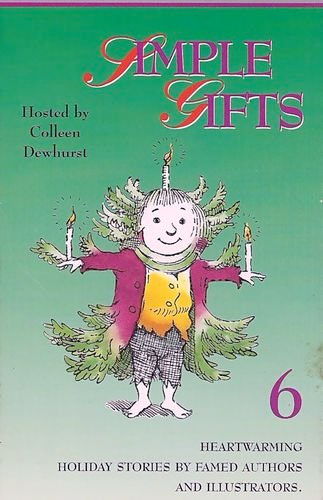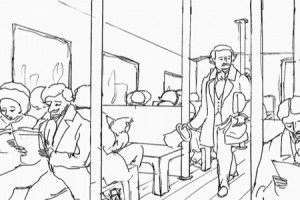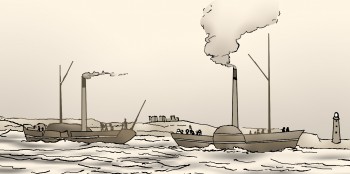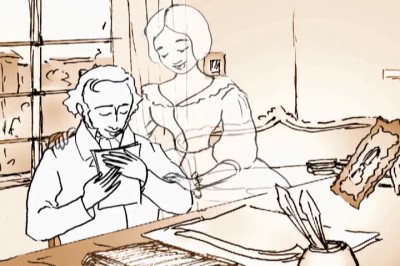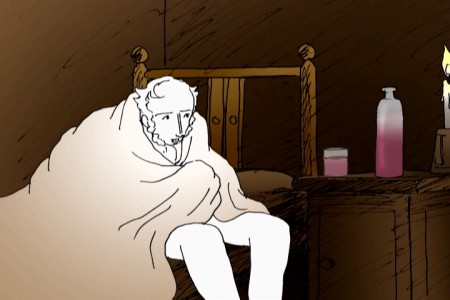Interview with Director Michael Sporn
Interviewed by James T. Nethery.
Michael Sporn’s blog is one of the most valuable resources on animation that’s packed with amazing articles, drawings, and model sheets. He very kindly accepted to do this excellent interview for us and it’s a great insight into the mind of a brilliant animation director.
Q: So lets start with your history before we get into Poe. How did you get interested in animation? Were there any animated films that inspired you to break into the industry?
I started out interested in animation. When I was four my mother recalls my demanding cartoons on the TV. (Back in 1950 there weren’t many cartoons on TV so she must have taken me to a movie theater.) By 12 I had bought a regular 8mm camera and started filming animation I had already done. Of course, that’s when I learned what parallax was, and had filmed the peg holes. (I animated on 3 hole looseleaf using an “Animation Kit drawing table” bought from the Disneyland Art corner.) By the time I started college at age 17 I had done 2½ hrs of animation on 8mm film.
Q: Did you go to school for animation? Or were you self taught?
I went to school to study animation but there was only one school in NY at the time that offered a degree and had an animation course, NY Institute of Technology. When I started they dumped the animation course. I focused on the art classes and continued to do animation on my own.
I was pretty much self-taught until I entered the business. Then, I had the best as teachers.
Q: What was the first studio you got a job at? I remember reading on your blog that early on in your career you worked with the likes of John Hubley and Tissa David. Any good stories about working with them?
With four months left in the Navy, I contacted a couple of animation studios and people saying I’d like to visit them during those four months to show my portfolio and try out for a starting position in their studio..
– I wrote a letter to Prescott Wright and got a response from Ward Kimball. He told me to “go into something more lucrative, like dairy farming.”
– I wrote to Vinny Cafarelli at Stars & Stripes Forever Productions, Inc. and got a response suggesting I wait until I was out of the service. However, he would be glad to show me the studio if I was interested when I was in NYC.
– I wrote to Ruth Gench at Paramount in NYC. She said the same as Vinny.
– I wrote to my hero, John Hubley. I got a letter back saying that they’d be glad to look at my portfolio anytime I wanted, and they were sure I would have a job waiting for me when I got out. It was signed, John Hubley.
I waited until I got of the Navy and called the Hubley Studio (known as Storyboard at the time). John’s Assistant, who answered the phone, hadn’t heard of me and didn’t know what letter I referred to. She suggested I call back next week. I did. John hadn’t heard of me. I sent the letter and called back a week later.
John had an Assistant, when I’d written, who was about to be fired, and she wrote the letter to me and forged John’s signature (not a bad job either). The new Assistant, Maggie Glass, couldn’t have been more friendly or helpful. My hopes were squashed. Except that Maggie told me to call back next week. Then the next week, then the next. Meanwhile, I’d gotten a job at Hal Seeger’s studio as a messenger. I was making less money there than I did on unemployment – $60. He gave me an extra $10 to mop the floors once a week. They did no animation, only editing of ads for ABC and made sound effects for the industry – building on Maurice Manne’s EFFX library. (Manne did all of Fleischer’s effects in the 30s & 40s and continued with Paramount until their close.) Hal Seeger had done animation and was close with Max Fleischer. I had a lot to learn from him, and I did while I worked toward learning the film industry, even if it wasn’t animation.
Week after week of calling the Hubley studio meant I became friendly with John’s personal assistant, Maggie. When a two day job on a commercial opened up, she helped get me in there. The two days turned into six months. The six months went on and off for four years until John’s death during DOONESBURY.
I knew John’s time was priceless, so I found questions to ask which incorporated a number of questions at the same time. I wanted the most from his answers and tried not to take up too much of his time. Yet my favorite memories of him often came back to the off-the-cuff comments.
I’d just bought a small history of world animation and had it on my desk when he came in. He saw the new book and picked it up and started to rifle through the pages. He asked if it was any good, and I gave a short review saying it was OK. He asked if Faith was in the book. (He’d already looked at the index and knew she wasn’t.) I said as much and he asked me to make sure she wouldn’t see the book. John was always protective of Faith.
I spent a lot of time reading and rereading the notes from the Disney after hours classes. I was especially interested in the Disney Layout course and learned quite a bit. John’s layouts for his own films were usually not more than rough poses for the characters as suggestions to the animators. Most of what he wanted from the animators came out of long conversations he’d have with them when doling out the work. However there were the rare BG layouts he’d provide. Unfortunately, John’s BG layouts were usually a mass of scrambled lines as if they were large doodles done during some phone conversation. John would sometimes bring these drawings to me for a light cleanup.
I can remember a church interior for the film PEOPLE PEOPLE PEOPLE. I had to look long and hard to see the church within those ragged lines.
There was another for EVERYBODY RIDES THE CAROUSEL. It was a children’s park. A boy on a tricycle was chasing a girl with a balloon. The park was just a few lines. I used what I learned from the Disney notes and built up something that I thought played nicely. About a week later, John said, in passing, that he’d forgotten to tell me what a good job I did on that drawing. I think that compliment carried me for about a year or two.
I can remember a Christmas gathering. This is the only time we were called into John’s studio, never mind sharing a glass of champagne. The conversation was a bit forced. John turned to the storyboard on the wall (for VOYAGE TO NEXT) and he pitched it to us. Since no dialogue was ever written on the Hubley boards, it was helpful to hear him give it. The only other time John went through a board for me was on two Vlasic pickle spots I did for him. Phil Duncan animated them. I did everything else from assisting and inbetweening to painting to animation changes to running the movieola for the client. I was there when John showed the second spot in final color to the Agency people. Two young guys that were very straight laced with their ties nice and tight. By the time the 30 sec spot had run, I turned around to witness two people who’d loosened their ties, crumpled up their suits and were visibly sweating. They were about to ask for changes on top of changes they’d already made. John ushered them out of the studio, had me send all the artwork to the Agency, and closed the books on the spot. John dumped the client when he’d decided he’d had enough. This second spot had a stork character with Edgar Buchanan’s voice. An old west telegraph operator type character. The spot went to Jack Zander who used a Groucho Marx impersonator and gave a completely different and boring take on a pelican.
I met Tissa David on the second day of working there and continued working with her privately throughout my career. She’s one of my closest friends in the business. It started when she came into Hubley’s studio, on my second day working there.
There were two of us in the art room, Helen Komar (a lifelong assistant animator who was acting as a production coordinator for Hubley) and me. Tissa looked at a scene on Helen’s desk, and she flipped it. “Who did these horrible inbetweens?” she asked in her very Hungarian accent. “They are the worst inbetweens I have ever seen.”
My head tried to duck down into my shirt since it was obvious that only one person in the room was doing inbetweens – me. Tissa then started teaching me weekly at her apartment. I’d take home some old scene by Grim Natwick and clean it up and/or inbetween it. Then Tissa would show me how horribly I’d done. This went on for years.
Q: According to your filmography, you worked with Richard Williams on his Raggedy Anne and Andy film. How did you come to meet Richard Williams and what was the environment like at his studio?
Many years before working with Hubley I’d seen a documentary about Dick Williams. I’d sent him a letter saying I’d like to work for him. He told me to bring myself to England and show my portfolio. Since I knew the military, the draft would eventually catch up with me, I decided it’d be best to wait. There I was, eventually, working at the Hubley Studio, and I remember mentioning this to Tissa. I can still recall her intonation when she said to “Please stay in the US. America needs good animators.” I said I had no plans on leaving the Hubley studio; they would have to leave me.
Several years later Tissa was working for Dick, and she’d already introduced the two of us. Once John Hubley went to England to work on WATERSHIP DOWN, I allowed myself to be pulled into Raggedy Ann. I started as an inbetweener, then became head of Assistants & Inbetweeners, then also did all the special effects animation in the film. I was very close with Dick and would often go with him to jazz clubs to hear him play his cornet.
The environment at Raggedy Ann was always hectic. At the beginning we sought perfection and would do a scene over and over a dozen times. I always had the knack of seeing ones on the screen and could easily locate mistakes in a scene. I learned to keep my mouth shut after a while, since it was costing too much to feign perfection. There were the weekly studio meetings with the producers and their hack studio manager. Always about money, with a new nasty edict every week.
There was one week when I was told to fire two inbetweeners to show that I could manage firing people and to make everyone else nervous about the financial situation. I thought it ridiculous but had to do it. Dick told me I had no choice; in fact, I think it was his idea to show that I was a strict and dominating leader.
One new inbetweener, at this very time, had decided that Jack Schnerk had done a bad job of animating a scene. She chose to fix his animation, and in the process she erased all of Jack’s drawings. She was fired without a second thought.
The second to be dumped was someone Dick didn’t like. He told me to fire this guy. It so happens that he was a brilliant artist who’d spent a lot of time with the head of backgrounds. I went to her, and she agreed to hire him once I let him go as an inbetweener. I fired him and told him to report to the head of BGs on Monday. Dick, it seems, had no problem with this. That person is still working in BG and Layout and has done quite well on many features. He’s a real talent.
Q: So you’ve had your own studio for many years. How did you come to start the studio? What are some tough decisions you’ve had to make throughout the years?
After Raggedy Ann, I worked as Asst. Director to R O Blechman on his PBS special, SIMPLE GIFTS. Getting the funding out of PBS was difficult, and it meant I had to work on a lot of commercials for over a year. I hated it and kept reminding Bob of this.
There was one commercial that was underbid. Too little money to do what they wanted. I kept asking Bob to go back to the Agency and ask for more money. He couldn’t do it and was prepared to take a substantial loss.
One day when he went out to lunch, I called the Agency and talked them into paying Bob an additional $5000 for the work we were doing. As I hung up the phone, pleased, I realized that I was a fool. In the one phone call, I got Bob enough money to cover my month’s salary. It was then that I pushed myself into working for myself and opened my own studio in February 1980. (As it is, I have the longest running studio in the City.)
So my toughest decision was actually starting the studio.
The second most difficult was a series of films Shelley Duvall was making for Showtime. They were adaptations of children’s books. She wanted me to do the series and flew me out to LA to discuss the series. Everything went well until after that meeting. I didn’t hear from them. I kept calling their lawyer, my contact, and he wouldn’t return the calls. Several months later, out of the blue, I got a call from Ms. Duvall. They were ready to start next week. I told her that I wasn’t ready to start, and in fact had decided not to go ahead with it. (I felt disrespected and figured that would be the relationship we’d have, and I wasn’t ready for that.) That call meant I lost a million dollar contract. My ego did it, and I would have done a good job on those films. It was a stupid move. Shelley Duvall and I talked about it when we met at the next year’s EMMY Awards.
Q: Any favorite films that you created at your studio?
Of the half hour films, there are several I like.
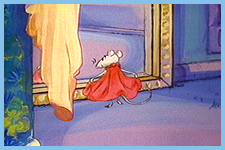
THE MARZIPAN PIG is just a great film. It’s adapted from a children’s book by Russell Hoban, a favorite of mine and wholly animated by Tissa David. It doesn’t get better than that.
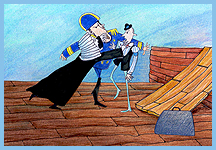
THE HUNTING OF THE SNARK is my favorite of the films I’ve animated. I felt close to Lewis Carroll with that one, and seriously thought about Existential vs. Romantic literature in terms of several of the characters within that film.

THE MAN WHO WALKED BETWEEN THE TOWERS is a very good adaptation of Mordecai Gerstein’s book. Matt Clinton did some fine animation in it.
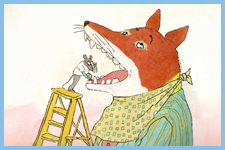
And of course I love DOCTOR DESOTO since I was nominated for the Oscar with that one. It got me out of the box in 1984.
Q: Moving on to Poe, how did you come up with the idea of doing a feature film based on Edgar Allan Poe’s life?
Originally, I had proposed a mini series of six shows adapting Poe’s stories for children to HBO. They loved the idea until they read one of his stories. That frightened them, and they ran from it.
When offered some seed money to start a feature, I chose POE. The entire prospect of the film is designed to recoup the investors’ money. Some day, I’ll go into that in length. Not now, though.
The more I researched Poe’s biography, the more interested I grew in the story. Maxine Fisher, my writing partner, made some brilliant choices, and the end result is our script. Jason McDonald did storyboards for three of the four stories. His artwork is inspirational, but some of the storytelling has to be reworked. The boards suffer from what I see as a problem with a lot of animation today; it’s designed more as a comic book (graphic novel, if you prefer) than as a film. But those inspirational style sketches are everything.
Q: You said in a blog post that Tissa David is working on the film. How did she come to be involved?
Tissa and I are very close. She’s worked for/with me on many of my films. I asked her to do a storyboard for Poe’s bio. She said she’d only do it as animatic. Basically, she did the layouts, so far, for about 20 minutes of the film.
|
|
When we ran out of the seed money, I had to stop work on the film and concentrate on making money. It hurt. Tissa stopped her work. She would have had to stop, anyway, since her sister was dying of Cancer, and Tissa went down to Washington DC to help her. When she returned to NY, Tissa was ill and had several years of difficult times. Now she is in good shape at 91 and considers herself retired. The only one she’ll work for anymore is me; so I am blessed. I also hope to get Ed Smith to animate on the film. Two great and living animators in New York. I have to see that they will offer some help to my film.
This is part of the reason that it’s urgent to get the film in production, sooner rather than later.
Q: How far are you in production on the Poe film? Have you started fully animating any scenes or are you still in the storyboard stage?
The script is done (except for changes that have taken place in my head and will face reality once we’re started.) The film has been storyboarded for about 85% of its whole. The last two sequences of the biography have to be done, and the last few minutes of the RUE MORGUE sequence has to be done. The animatic for the biographic sections (Tissa’s work) has been done for about 20 minutes. Several key voices are recorded and cut into the work print. Some small bits of animation have been done.
The final style hasn’t been set, and no final animation has been done.
This was my reason for doing the Indiegogo campaign. I wanted to raise some capital to set the style of the film and get the energy moving forward. That part has already begun even though the deadline has not come up yet.
Q: How many people are currently working on Poe? How big is the staff?
The film hasn’t begun. Preproduction is almost complete. No one (other than me) is working on the film. I don’t have money, as yet, to pay anyone.
However, we are close to completing a Cable TV deal. This wouldn’t pay a lot but would give us that initial traction that would get us to raise the money. Pre-sales in Europe would give us a good share of the budget, and we have a British sales agent ready to go once the Cable company tells us how much their offer will be.
Once we get going there will be about eight to ten people working on the film. That’s pretty much set already, and the people know who they are. It should be a fun 16 months.
Q: How did you get the idea to use IndieGogo and Kickstarter to fund your film?
It didn’t take much thought to use these services. I was originally going to do it for a short film I’ve been working on, adapting an F. Scott Fizgerald short story. We’ve animated about two minutes of that one. However, I decided it was time to kick things into gear, and I went forward with POE, instead.
Click the image to go to the POE IndieGogo page:
Update from Michael Sporn: “POE is finished on Indiegog, and it did its job. Including money sent directly to me, we made the goal of $13000 to be able to do the promo for the film. It feels good to have come through it and still be up and kicking.”
Q: What are your thoughts on feature animation today in the United States?
Things are in a poor state. I’m not the biggest fan of cgi animation, and feel that all of the films are getting to look alike. THE LORAX and DESPICABLE ME are pretty much the same, visually.
I like 2D graphic animation (what used to be called cel animation.) There have been some excellent films in the past few years. Miyazaki and Sylvain Chomet are brilliant, and I wait with bated breath for films from either of them. Several decent films from Europe such as A CAT IN PARIS and CHICO AND RITA. They all have flaws. But they’re better than most.
14. Any animated films today that stand out to you?
There are many short films that stand out for me. Yuri Norshtein is still my favorite animation filmmaker, today, though I also like Koji Yamamura’s work. Features, as I said, are in the hands of Miyazaki and Chomet. I’d like to see something directed by Andreas Deja; his sensibilities are my favorite of the Disney animators.
15. What is your advice to somebody who wants to break in to the animation industry?
As long as you’re looking for cgi, there are probably openings. If you want to do non-TV good 2D animation do it yourself and keep your eyes open to the few who still do this form. Then, keep knocking on the doors.
16. Any closing thoughts?
2D animation is not dead. In fact, the surface has barely been scratched. Eventually the cgi people will figure this out and stop doing films about little doll-like characters and will turn their computers onto the Art of the business. Maybe I’m still dreaming.
Image Sources:
